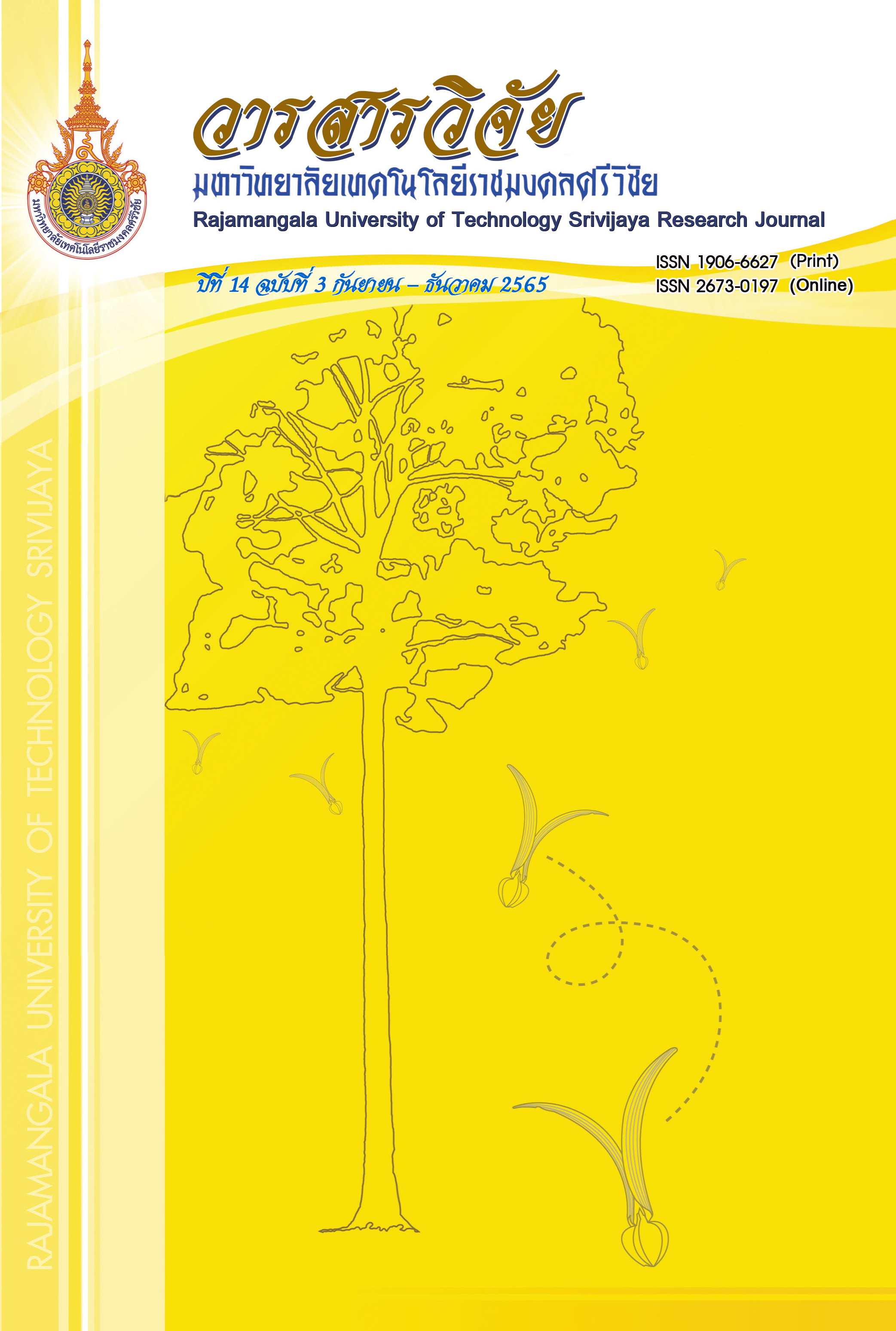การห่อหุ้มน้ำมันงาขี้ม้อนโดยวิธีการทำแห้งแบบพ่นฝอย และการฉีดพ่นฝอยร่วมกับตู้อบลมร้อน
คำสำคัญ:
การห่อหุ้ม, น้ำมันงาขี้ม้อน, มอลโตเด็กซ์ตริน, โปรตีนถั่วเหลือง, การละลายบทคัดย่อ
งานวิจัยนี้มีวัตถุประสงค์เพื่อศึกษาวิธีการห่อหุ้มน้ำมันงาขี้ม้อน โดยใช้สารห่อหุ้มที่มีอัตราส่วนของ
มอลโตเดกซ์ตริน และโปรตีนถั่วเหลือง 9:1 ในน้ำ เพื่อใช้ห่อหุ้มน้ำมันงาขี้ม้อนทั้งหมด 3 ระดับ ที่ระดับ 10, 20 และ 30% (w/v) โดยกระบวนการทำแห้งแบบพ่นฝอยและการฉีดพ่นฝอยน้ำมันร่วมกับการใช้ตู้อบลมร้อน เพื่อประเมินคุณสมบัติในการห่อหุ้มน้ำมันในระหว่างการเก็บรักษา และความสามารถในการละลาย ผลการทดลองพบว่าสูตรที่เหมาะสม คือไมโครแคปซูลที่ทำแห้งแบบพ่นฝอย สูตรใช้ปริมาณน้ำมันงาขี้ม้อน ที่ระดับ 20% (w/v) เนื่องจากมีประสิทธิภาพการห่อหุ้มสูงที่สุด (80.73%) มีค่าความสามารถในการละลายน้ำได้ดีที่สุด (84.97%) และมีค่าเพอร์ออกไซด์ไม่เกินร้อยละ 20 มิลลิกรัมสมมูลย์ออกซิเจนต่อกิโลกรัมตัวอย่าง ผลิตภัณฑ์ที่ได้มีค่าปริมาณความชื้น (4.71%) aw (0.31) มีค่าสีความสว่าง (L*) เท่ากับ 91.85 ค่าความเป็นสีแดง-เขียว (a*) เท่ากับ -0.57 และค่าความเป็นสีเหลือง-น้ำเงิน (b*) เท่ากับ 9.89 จากการวิเคราะห์คุณลักษณะด้านจุลภาคด้วยกล้องจุลทรรศน์อิเล็กตรอนแบบส่องกราด (SEM) พบว่า ผิวของไมโครแคปซูลที่ทำแห้งแบบพ่นฝอย มีการเกาะติดกัน มีรอยบุบตรงกลาง หรือรอยย่นเพิ่มขึ้นตามปริมาณน้ำมันงาขี้ม้อน ส่วนไมโครแคปซูลที่ทำแห้งด้วยตู้อบลมร้อน ไม่มีรอยบุบตรงกลาง และมีขนาดอนุภาคที่ใหญ่กว่าการทำแห้งแบบพ่นฝอย ดังนั้นไมโครแคปซูลน้ำมันงาขี้ม้อนที่ได้จากศึกษาในครั้งนี้ เหมาะสมที่จะนำไปเติมในผลิตภัณฑ์เครื่องดื่มเพื่อเสริมคุณค่าทางอาหารต่อไป
เอกสารอ้างอิง
Alamed, J., Chaiyasit, W., Mcclements, D.J. and Decker, E.A. 2009. Relationships between Free Radical Scavenging Antioxidant Activity in Foods. Jounal of Agricutural and Food Chemistry 57: 2969-2976.
Albert, B.B., Derraik, J.G.B., Cameron-Smith, D., Hofman, P.L., Tumanov, S., Villas-Boas, S.G., Garg, M.L. and Cutfield, W.S. 2015. Fish oil supplements in New Zealand are highly oxidised and do not meet label content of n-3 PUFA. Scientific Reports 5(1): 7928.
Anwar, S.H. and Kunz, B. 2011. The influence of drying methods on the stabilization of fish oil microcapsules: comparison of spray granulation, spray drying, and free drying. Journal of Food Engineering 105: 367-378.
Azizi, N., Najafpour, G. and Younesi, H. 2017. Acid pretreatment and enzymatic saccharification of brown seaweed for polyhydroxybutyrate (PHB) production using Cupriavidus necator. International Journal of Biological Macromolecules 101: 1029-1040.
Chang, C., Varankovich, N. and Nickerson, M.T. 2016. Microencapsulation of canola oil by lentil protein isolate- based wall Materials. Food Chemistry 212: 264-273.
Dorni, C., Sharma, P., Saikia, G. and Longvah, T. 2018. Fatty acid profile of edible oils and fats consumed in India. Food Chemistry 238: 9-15.
Encina, C., Vergara, C., Gimenez. B., Oyarzun-Ampuero, F. and Robert, P. 2016. Conventional spray-drying and future trends for the microencapsulation of fish oil. Trends in Food Science and Technology 56: 46-60.
Goyal, A., Sharma, V., Sihag, M.K., Tomar, S.K., Arora, S. and Sabikhi L. 2015. Development and physico-chemical characterization of microencapsulated flaxseed oil powder: a functional ingredient for omega-3 fortification. Powder Technology 286: 527-537.
Jay, J.M. 2000. Modern Food Microbiology. 6th Edition. Aspen Publishers, Inc., Gaithersburg.
Kausadikar, S., Gadhave, A.D. and Wanghmare, J. 2015. Microencapsulation of lemon oil by spray drying and its application in flavor tea. Advances in Applied Science Research 6(4): 69-78.
Nesterenko, A., Alric, I., Silvestre, F. and Durrie, V. 2013. Vegetable proteins in microencapsulation: A review of recent interventions and their effectiveness. Industrial Crops and Products 42: 469-479.
Pegg, R.B. 2005. Measurement of primary lipid oxidation products, pp 515-564. In Wrolstad, R.E., Acree, T.E., Decker, E.A., Penner, MH., Reid, D.S., Schwartz, S.J., Shoemaker, C.F., Smith, D.M. and Sporns, P., eds. Handbook of food analytical chemistry. John Wiley & Sons, Inc., Hoboken, NJ, USA.
Sheu, T.Y. and Rosenberg, M. 1998. Microstructure of microcapsules consisting of whey proteins and carbohydrates. Journal of Food Science 63(3): 491-494.
Silva, P.L., Stringheta, P.C., Teófilo, R.F. and Oliveira, L.R. 2013. Parameter optimization for spray-drying microencapsulation of jaboticaba (Myrciaria jaboticaba) peel extracts using simultaneous analysis of responses. Journal of Food Engineering 117(4): 538-544.
Siriamornpun, S., Li, D., Yang, L., Suttajit, S. and Suttajit, M. 2006. Variation of lipid and fatty acid compositions in Thai Perilla seeds grown at different location. Songklanakarin Journal of Science and Technology 28(Suppl. 1): 17-21.
Tan, S.Y., Teh, C., Ang, C.Y., Li, M., Li, P., Korzh, V. and Zhao, Y. 2017. Responsive mesoporous silica nanoparticles for sensing of hydrogen peroxide and simultaneous treatment toward heart failure. Nanoscale 9(6): 2253-2261.
Timilsena, Y. P., Vongsvivut, J., Adhikari, R. and Adhikari, B. 2017. Physicochemical and thermal characteristics of Australian chia seed oil. Food Chemistry 228: 394-402.
Wannarot, N. 2019. Product Development of low fat-creamer powder using Hom Mali Rice substitution. Master's Thesis, Mahasarakham University. (in Thai)
Wongsawat, P., Nopparat, M., Ruangdej, K., Phapan, W. and Lertrungpanit, A. 2003. Physical properties of spray dried and reconstituted soya milk, pp. 242-250. 41th Kasetsart University Annual Conference: Agro-Industry. Department of Agro Industry, Faculty of Agro Industry, Kasetsart University. (in Thai)
ดาวน์โหลด
เผยแพร่แล้ว
รูปแบบการอ้างอิง
ฉบับ
ประเภทบทความ
สัญญาอนุญาต
ลิขสิทธิ์ (c) 2022 วารสารวิจัย มหาวิทยาลัยเทคโนโลยีราชมงคลศรีวิชัย

อนุญาตภายใต้เงื่อนไข Creative Commons Attribution-NonCommercial-NoDerivatives 4.0 International License.
เนื้อหาและข้อมูลในบทความที่ลงตีพิมพ์ในวารสารวิจัยมหาวิทยาลัยเทคโนโลยีราชมงคลศรีวิชัย ถือเป็นข้อคิดเห็นและความรับผิดชอบของผู้เขียนบทความโดยตรง ซึ่งกองบรรณาธิการวารสารไม่จำเป็น ต้องเห็นด้วย หรือร่วมรับผิดชอบใดๆ
บทความ ข้อมูล เนื้อหา รูปภาพฯลฯ ที่ได้รับการตีพิมพ์ในวารสารวิจัย มหาวิทยาลัยเทคโนโลยีราชมงคลศรีวิชัย ถือเป็นลิขสิทธ์ของวารสารวิจัย มหาวิทยาลัยเทคโนโลยีราชมงคลศรีวิชัย หากบุคคลหรือหน่วยงานใดต้องการนำทั้งหมดหรือส่วนหนึ่งส่วนใดไปเผยแพร่ต่อหรือเพื่อการกระทำการใดๆจะต้องได้รับอนุญาตเป็นลายลักษ์อักษรจากวารสาร มหาวิทยาลัยเทคโนโลยีราชมงคลศรีวิชัยก่อนเท่านั้น







